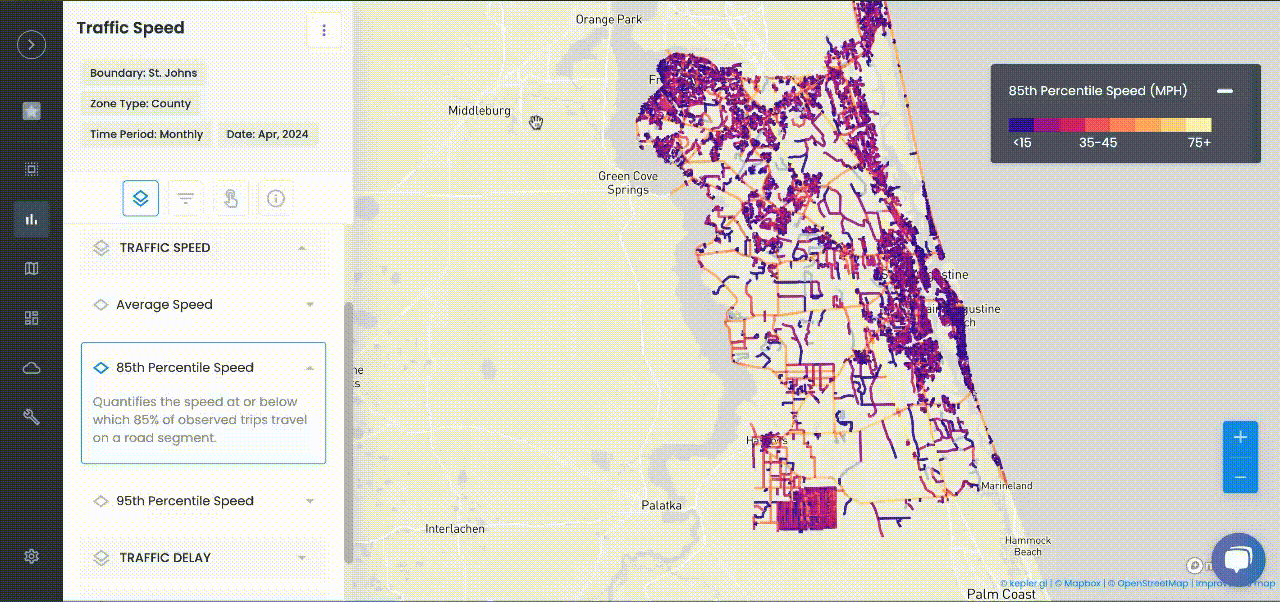
Congestion Management
Mobility-as-a-Service: Integrating Data for Seamless City Transportation Platforms
Traffic data can support mobility-as-a-service by integrating transit, micromobility, and traffic data for smarter urban travel.
Imagine planning a trip in your city where, instead of juggling multiple apps and tickets, you open one platform that shows all your options in one place—bus, metro, rideshare, bike-share, scooters, maybe even a taxi or car rental—and lets you plan and pay for the entire journey seamlessly. This is the promise of Mobility-as-a-Service (MaaS). MaaS is an integrated approach to urban transportation where travelers access numerous modes through a single digital interface.
The goal is to make using public and shared transportation as convenient as owning a private car—thereby reducing single-occupant vehicle use and promoting sustainable, multimodal travel. Data integration is central to MaaS: it depends on real-time access to schedules, availability, pricing, and payments across all providers.
Breaking Down Silos – Data Integration
Historically, transportation modes operated in silos. Public transit had one app, bike-share another, and rideshare something else. MaaS platforms remove these barriers by aggregating datasets via open standards like GTFS and GBFS. A traveler might use one app to walk to a bike-share, ride to the train, and finish the last mile via rideshare—all in one seamless plan.
Urban SDK supports this integration through its Mobility Intelligence platform, which visualizes multimodal infrastructure, traffic conditions, and mobility patterns in real time. This enables planners to analyze demand, identify access gaps, and make informed decisions about multimodal transportation investments.
Encouraging Multimodal Behavior
MaaS not only streamlines access—it changes behavior. In Helsinki, MaaS users became more likely to combine modes like rail and scooter, or transit and bike-share. In cities like Sanford, Florida, Urban SDK's real-time data tools were used to monitor transportation demand, helping leaders better allocate resources across active and motorized travel options.
Our platform provides planners with insights into how people move—not just mode-by-mode, but trip-by-trip—so they can deploy infrastructure and services that actually match evolving demand.
MaaS Subscription Models – Mobility Bundles
Some cities now offer monthly bundles (like a Netflix for transit) where users get unlimited bus rides, bike-share minutes, and discounted rideshare credits. This encourages shared mobility over car ownership. With MaaS, instead of paying for gas, parking, and insurance, you pay one predictable monthly fee.
Urban SDK supports this with tools to track traffic volume, usage trends, and travel time delays, giving cities the metrics they need to optimize bundle offerings and infrastructure investments around demand patterns.
Challenges and the Path Forward
True MaaS requires cooperation. In Finland, laws mandated that operators share data openly. In the U.S., this is emerging through partnerships like Dallas Area Rapid Transit and Uber. But equitable access must also be ensured—smartphones, digital wallets, and mobility accounts should serve all residents, not just the tech-savvy.
Urban SDK helps address these gaps by enabling agencies to map multimodal access across neighborhoods. For example, in El Cajon, California, our platform helped planners use data to address street safety and accessibility in high-demand areas—exactly the kind of planning MaaS requires for equity and effectiveness.
From the Traveler’s Perspective
MaaS empowers users. Is your subway delayed? The app offers a scooter alternative. Raining outside? Rideshare surfaces instantly. Urban SDK enables this kind of responsiveness by powering the real-time mobility layers that agencies use to deliver reliable, flexible transit experiences.
In Conclusion
Mobility-as-a-Service flips the planning model from mode-first to user-first. By integrating transit, rideshare, micromobility, and payment systems into one platform, cities make it easier for residents to ditch their cars—and choose smarter, cleaner travel instead.
At Urban SDK, we provide the tools cities need to build these next-generation mobility ecosystems:
- Mobility Intelligence to integrate and visualize multimodal data
- Traffic volume, speed, and travel time delay metrics to understand demand
- Real-world case studies showing data-driven planning success in action
The future of city travel is seamless, sustainable, and smart—and with Urban SDK, it’s already taking shape.
FAQs
Q1. What is Mobility-as-a-Service (MaaS)?
Ans: MaaS is an integrated digital platform that combines multiple transportation options - public transit, bike-share, ride-hailing, scooters, taxis - into a single app for planning, booking, and payment, aiming for seamless multimodal trips.
Q2. How does MaaS benefit city residents?
Ans: MaaS makes urban travel convenient by offering one-stop itineraries and payments, reducing reliance on private cars, improving access to different transport modes, and encouraging sustainable, multimodal travel.
Q3. What types of transport are included in MaaS?
Ans: Typical MaaS services include buses, trains, metros, shared bikes and scooters, car rentals, ride-hailing, and sometimes emerging modes like air taxis. The goal is to provide flexible choices tailored to user needs.
Q4. How does MaaS help cities manage mobility more sustainably?
Ans: By promoting shared, public and active transportation, MaaS reduces vehicle miles traveled, traffic congestion, and emissions. It allows cities to plan services dynamically based on real demand and environmental goals.
Q5. What role does data integration play in MaaS?
Ans: MaaS depends on integrating schedules, availability, pricing, and payments from many providers into unified, real-time platforms using open data standards like GTFS and GBFS.
Q6. Are MaaS subscription models available?
Ans: Yes, many cities offer MaaS bundles - monthly or yearly plans that include transit, bike-share, and ride credits - simplifying payments and incentivizing multimodal travel.
Q7. Does MaaS promote equitable access to transportation?
Ans: MaaS platforms aim to serve all residents, including those in underserved areas. Cities use demographic data to ensure mobility offerings reach diverse populations fairly and inclusively.
Q8. How is MaaS changing traditional transportation planning?
Ans: MaaS shifts planning from individual modes to integrated, user-centric services. It enables data-driven management of multimodal networks responsive to evolving travel behaviors, especially post-pandemic.
Q9. What challenges exist in implementing MaaS?
Ans: Challenges include data sharing limitations, technology interoperability, digital access inequities, and aligning diverse service providers under common frameworks.
Q10. How does Urban SDK support MaaS implementation?Ans: Urban SDK provides mobility intelligence platforms that integrate multimodal, demographic, and traffic data, helping cities understand patterns, plan service bundles, track impact, and promote equitable access.

TRAFFIC ENFORCEMENT FEATURES
80% of citizen complaints
are a perception problem
Urban SDK provides precise hourly speed data to evaluate complaints and deploy resources efficiently for the greatest impact to public safety.
Urban SDK provides precise hourly speed data to evaluate complaints and deploy resources efficiently for the greatest impact to public safety.
Target Speeding
Identify hot spots, validate monthly speeding trends and monitor vulnerable areas like school zones.
Improve Safety
Crash and citations location information to compare speed trends month over month
Fast Response
Respond to citizen complaints sooner with address search and exportable reporting
Deploy Assets
Generate maps for traffic enforcement by time of day, location or division to deploy officers to known problem areas.
RESOURCES
Customer Success
See how public sector leaders succeed with Urban SDK.
WEBINAR
Identify speeding and proactively enforce issues
See just how quick and easy it is to identify speeding, address complaints, and deploy officers.







